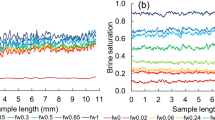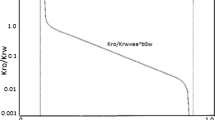Abstract
Relative permeability (kr) data are the key factors for describing the behaviour of the multi-phase flow in porous media. During the kr measurements of low-permeability rocks, high capillary pressure can cause a significant liquid hold-up at the core outlet. This liquid hold-up, which is known as capillary end effect (CEE), is the main difficulty for laboratory measurements of relative permeability (kr) for tight and shale rocks. In this paper, a novel method is proposed to correct the CEE during the steady-state relative permeability (SS-kr) measurements. The integrity of the proposed method is evaluated by a set of artificially generated data and the experimental SS-kr data of an Eagle Ford shale sample. It is shown that accurate kr data can be obtained using the proposed technique. This technique can be used to estimate reliable kr data without any saturation profile measurement equipment, such as CT scan or MRI.









Similar content being viewed by others
Abbreviations
- A :
-
Area
- K :
-
Absolute permeability
- q :
-
Flow rate
- S :
-
Saturation
- F :
-
Liquid/gas flow rate ratio
- P :
-
Pressure
- L :
-
Length
- x :
-
Distance
- F :
-
Liquid/gas flow rate ratio
- \( S_{\text{o}}^{*} \) :
-
Wetting phase (oil) saturation
- \( \overline{S}_{\text{o}} \) :
-
Average wetting phase (oil) saturation
- IFT:
-
Interfacial tension
- μ :
-
Viscosity
- g:
-
Gas
- o:
-
Oil
- c:
-
Capillary pressure
- or:
-
Residual oil
- gr:
-
Residual gas
- ro:
-
Oil relative permeability
- rg:
-
Gas relative permeability
- out:
-
Outlet
- Exp:
-
Experimental
- CEE:
-
Capillary end effect
- unaf:
-
Unaffected
- t:
-
Total
- r:
-
Relative
- CEE:
-
Capillary end effect
- SS:
-
Steady state
- LGR:
-
Liquid/gas flow rate ratio
References
Al Hinai, A., Rezaee, R., Esteban, L., Labani, M.: Comparisons of pore size distribution: a case from the Western Australian gas shale formations. J. Unconv. Oil Gas Resour. 8, 1–13 (2014)
Chalmers, G.R., Ross, D.J., Bustin, R.M.: Geological controls on matrix permeability of Devonian Gas Shales in the Horn River and Liard basins, northeastern British Columbia, Canada. Int. J. Coal Geol. 103, 120–131 (2012)
Chen, A., Wood, A.: Rate effects on water-oil relative permeability. In: Proceedings of the International Symposium of the Society of Core Analysts, Edinburgh, Scotland, pp. 17–19 (2001)
Gupta, R., Maloney, D.R.: Intercept method: a novel technique to correct steady-state relative permeability data for capillary end effects. SPE Reserv. Eval. Eng. 19, 316 (2016)
Honarpour, M., Mahmood, S.: Relative-permeability measurements: an overview. J. Petrol. Technol. 40, 963–966 (1988)
Honarpour, M., Koederitz, F., Herbert, A.: Relative permeability of petroleum reservoirs. CRC Press, Boca Raton (1986)
Huang, D.D., Honarpour, M.M.: Capillary end effects in coreflood calculations. J. Petrol. Sci. Eng. 19, 103–117 (1998)
Iglauer, S., Favretto, S., Spinelli, G., Schena, G., Blunt, M.J.: X-ray tomography measurements of power-law cluster size distributions for the nonwetting phase in sandstones. Phys. Rev. E 82, 056315 (2010)
Leverett, M.: Capillary behavior in porous solids. Trans. AIME 142, 152–169 (1941)
Maini, B., Coskuner, G., Jha, K.: A comparison of steady-state and unsteady-state relative permeabilities of viscocities oil and water in Ottawa sand. J. Can. Petrol. Technol. 29, 55 (1990)
Maloney, D., Wegener, D., Zornes, D.: New x-ray scanning system for special core analyses in support of reservoir characterization. Pap. SCA 9940, 1–4 (1999)
Meng, Q., Liu, H., Wang, J.: A critical review on fundamental mechanisms of spontaneous imbibition and the impact of boundary condition, fluid viscosity and wettability. Adv. Geo Energy Res. 1, 1–17 (2017)
Nazari Moghaddam, R., Jamiolahmady, M.: Slip flow in porous media. Fuel 173, 298–310 (2016)
Osoba, J., Richardson, J., Kerver, J., Hafford, J., Blair, P.: Laboratory measurements of relative permeability. J. Petrol. Technol. 3, 47–56 (1951)
Qadeer, S., Dehghani, K., Ogbe, D., Ostermann, R.: Correcting Oil–Water Relative Permeability Data for Capillary End Effect in Displacement Experiments. Springer, Berlin (1991)
Rapoport, L., Leas, W.: Properties of linear waterfloods. J. Petrol. Technol. 5, 139–148 (1953)
Richardson, J., Kerver, J., Hafford, J., Osoba, J.: Laboratory determination of relative permeability. J. Petrol. Technol. 4, 187–196 (1952)
Romanenko, K., Balcom, B.J.: An assessment of non-wetting phase relative permeability in water-wet sandstones based on quantitative MRI of capillary end effects. J. Petrol. Sci. Eng. 110, 225–231 (2013)
Shen, J., Bae, J.: An automated steady-state relative permeability measurement system. Pap. SPE 17217, 0.012–010.002 (1987)
Virnovsky, G., Skjaeveland, S., Surdal, J., Ingsoy, P.: Steady-state relative permeability measurements corrected for capillary effects. In: SPE Annual Technical Conference and Exhibition, SPE 30541, Society of Petroleum Engineers (1995)
Virnovsky, G., Vatne, K., Skjaeveland, S., Lohne, A.: Implementation of multirate technique to measure relative permeabilities accounting. In: SPE Annual Technical Conference and Exhibition, Society of Petroleum Engineers (1998)
Withjack, E.: Computed tomography for rock-property determination and fluid-flow visualization. SPE Form. Eval. 3, 696–704 (1988)
Acknowledgements
This study was conducted as a part of the Unconventional Gas and Gas-condensate Recovery Project at Heriot-Watt University. This research project is sponsored by Daikin, Dong Energy, Ecopetrol/Equion, ExxonMobil, GDF, INPEX, JX-Nippon, Petrobras, RWE, Saudi-Aramco and TOTAL, whose contribution is gratefully acknowledged.
Author information
Authors and Affiliations
Corresponding author
Additional information
Publisher's Note
Springer Nature remains neutral with regard to jurisdictional claims in published maps and institutional affiliations.
Appendix 1
Appendix 1
Gupta and Maloney (2016) proposed the intercept technique to correct CEE during relative permeability measurements. The intercept method was proposed to correct CEE errors from both pressure and saturation measurements for each LGR. In this technique, several measurements of rate versus pressure drop are required at the same LGR. The obtained trends in pressure drop versus rate and saturation versus rate will be used to correct the data for each single LGR. To correct the pressure data, one can start with Darcy’s equation as follows
where \( \Delta P_{\text{theoritical without CEE}} \) is the pressure drop across the core without any capillary contribution to the pressure drop. \( \Delta P_{\text{theoritical without CEE}} \) can be expressed as the difference between the experimental pressure drop across the core \( \Delta P_{\text{Exp}} \) and the pressure drop resulting from the \( \Delta P_{\text{CEE}} \). Therefore,
Rearranging Eq. A-2 gives
Using the above concept, Gupta and Maloney proposed to obtain \( \Delta P_{\text{CEE}} \) from the intercept of the plot of laboratory-measured pressure drop across the core (\( \Delta P_{\text{Exp}} \)) and the injected total flow rate (\( q_{t } ). \)
To correct the saturation data, they used the following overall saturation balance equation for a given fractional flow condition:
where \( x_{i} \) is the length of CEE region, \( S_{\text{w, avg}} \) is average water saturation, \( S_{\text{w, CEE}} \) is average saturation of CEE region, and \( S_{\text{w, true}} \) is actual water saturation as shown in Fig. 10.
Schematic of water saturation highlighting the average water saturation (\( S_{\text{w, avg}} \)), average saturation of CEE region (\( S_{\text{w, CEE}} \)) and asymptotic water saturation (\( S_{\text{w, true}} \)) presented by Gupta and Maloney (2016)
They defined CEE length factor as \( \beta = \frac{{x_{i} }}{L} \) and proposed the following equation as a reliable concept to correct the saturations.
Rearranging Equation A-4 and using Equation A-5 gives the expression
Based on Equation A-6, CEE-corrected saturation (i.e. \( S_{\text{w, true}} \)) is the intercept of the plot of (\( \frac{1}{{\left( {1 - \beta } \right)}} S_{\text{w, avg}} ) \) and (\( \frac{\beta }{{\left( {1 - \beta } \right)}} \)).
Rights and permissions
About this article
Cite this article
Nazari Moghaddam, R., Jamiolahmady, M. Steady-State Relative Permeability Measurements of Tight and Shale Rocks Considering Capillary End Effect. Transp Porous Med 128, 75–96 (2019). https://doi.org/10.1007/s11242-019-01236-8
Received:
Accepted:
Published:
Issue Date:
DOI: https://doi.org/10.1007/s11242-019-01236-8





